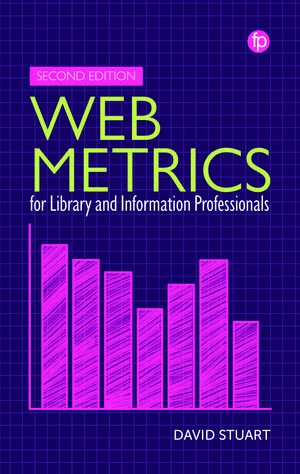Web Metrics for Library and Information Professionals: Second Edition
Autor David Stuarten Limba Engleză Paperback – 9 ian 2024
The book will begin with a wider discussion on the role of metrics, and how web metrics overlap with associated concepts with a longer library and information science history such as scientometrics and bibliometrics. It will explore the latest tools that are available, many of which have changed since the publication of the first edition, as well as how we can expect the field to change in the future with machine intelligence and artificial intelligence becoming more widely available.
This new edition has been extended and updated throughout to reflect the rapidly changing nature of the field. As well as updates to the user-friendly tools and resources, there is a greater emphasis on the programming libraries that are available, as library and information professionals are increasingly willing to start engaging with data that is available programmatically.
Preț: 405.85 lei
Preț vechi: 501.05 lei
-19% Nou
Puncte Express: 609
Preț estimativ în valută:
77.67€ • 80.59$ • 64.92£
77.67€ • 80.59$ • 64.92£
Carte indisponibilă temporar
Doresc să fiu notificat când acest titlu va fi disponibil:
Se trimite...
Preluare comenzi: 021 569.72.76
Specificații
ISBN-13: 9781783305667
ISBN-10: 1783305665
Pagini: 224
Dimensiuni: 152 x 229 x 16 mm
Greutate: 0.34 kg
Ediția:Second Edition
Editura: American Library Association
Colecția Facet Publishing
ISBN-10: 1783305665
Pagini: 224
Dimensiuni: 152 x 229 x 16 mm
Greutate: 0.34 kg
Ediția:Second Edition
Editura: American Library Association
Colecția Facet Publishing
Public țintă
Postgraduate, Professional Practice & Development, and Professional ReferenceNotă biografică
David Stuart is an independent information professional, Bibliometrics Officer at the University of St Andrews and an Honorary Research Fellow at the University of Wolverhampton. He has published widely in in peer-reviewed academic journals and professional journals on information science, metrics, and semantic web technologies and is author of a number of books, including Practical Ontologies for Information Professionals (2016), Facilitating Access to the Web of Data (2011), and Practical Data Science for Information Professionals (2020).
Cuprins
1 Introduction
Metrics
Indicators
Web metrics and Ranganathan's laws of library science
Web metrics for the library and information professional
Responsible metrics
The aim of this book
The structure of the rest of this book
2 Bibliometrics, Altmetrics, Web metrics, and Webometrics
Introduction
Web metrics
Information science metrics
Web analytics
Relational and evaluative metrics
Validating the results
Conclusion
3 Data Collection Tools
Introduction
The anatomy of a URL, web links and the structure of the web
Search engines 1.0
Web crawlers
Search engines
Post Search Engine 2.0: fragmentation
Conclusion
4 Evaluating Web Impact
Introduction
Websites
Blogs
Wikis
Internal v. External Metrics
Internal metrics
External metrics
A systematic approach to content analysis
Conclusion
5 Evaluating Social Media Impact
Introduction
Aspects of social network sites
Typology of social network sites
The most popular social media services
Sentiment analysis
Conclusion
**6 Relational Web Metrics and Social Network **
Analysis
Introduction
Social network analysis methods
Node centrality
Cluster identification
Statistical properties of the graph
Topic modelling
Sources for relational network analysis
Two R Examples
Conclusion
7 Web Bibliometrics
Introduction
More bibliographic items
New bibliographic sources
Full text analysis
Greater Context
Conclusion
8 Web Metrics for Data and Code
Introduction
The web of data
From data documents……to a semantic web?
The Importance of Code
GitHub Statistics
A Brief Exploration of Code-metrics with R Conclusion
9 The Future of Web Metrics and the Library and Information Professional
Introduction
How far we have come
The future of web metrics
The future of the library and information professional and web metrics
Metrics
Indicators
Web metrics and Ranganathan's laws of library science
Web metrics for the library and information professional
Responsible metrics
The aim of this book
The structure of the rest of this book
2 Bibliometrics, Altmetrics, Web metrics, and Webometrics
Introduction
Web metrics
Information science metrics
Web analytics
Relational and evaluative metrics
Validating the results
Conclusion
3 Data Collection Tools
Introduction
The anatomy of a URL, web links and the structure of the web
Search engines 1.0
Web crawlers
Search engines
Post Search Engine 2.0: fragmentation
Conclusion
4 Evaluating Web Impact
Introduction
Websites
Blogs
Wikis
Internal v. External Metrics
Internal metrics
External metrics
A systematic approach to content analysis
Conclusion
5 Evaluating Social Media Impact
Introduction
Aspects of social network sites
Typology of social network sites
The most popular social media services
Sentiment analysis
Conclusion
**6 Relational Web Metrics and Social Network **
Analysis
Introduction
Social network analysis methods
Node centrality
Cluster identification
Statistical properties of the graph
Topic modelling
Sources for relational network analysis
Two R Examples
Conclusion
7 Web Bibliometrics
Introduction
More bibliographic items
New bibliographic sources
Full text analysis
Greater Context
Conclusion
8 Web Metrics for Data and Code
Introduction
The web of data
From data documents……to a semantic web?
The Importance of Code
GitHub Statistics
A Brief Exploration of Code-metrics with R Conclusion
9 The Future of Web Metrics and the Library and Information Professional
Introduction
How far we have come
The future of web metrics
The future of the library and information professional and web metrics
Descriere
After reading this book the information professional will not only be better placed to adopt web metrics in their workplace, but also be critical of the misuse of web metrics.
